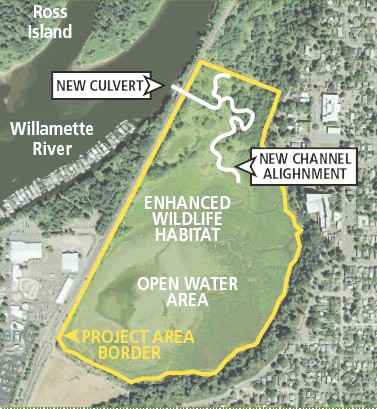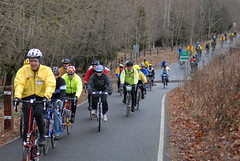As I reported back in March, next summer, from June to the end of September, the Springwater Corridor Trail on the Willamette River will be closed for a major project at Oaks Bottom Wildlife Refuge.
As a vital link from Sellwood to downtown Portland and the preferred commute route for an estimated 2,000 daily weekday commuters and around 5,000 daily users on the weekends, the closure is not being taken lightly. Last night, staff from the Bureau of Environmental Services (BES) and City Nature came to the City’s Bike Advisory Committee meeting to share details about the project and to present their latest thinking on detour plans.
“Take this [detour] as seriously as you would take a road.”
— Andrew Halliburton, BAC member
Sean Bistoff with BES told the committee that the goal of their Oaks Bottom Wildlife Refuge Enhancement Project is to reestablish the tidal connection between the Willamette River and the 170 acres of wetlands at Oaks Bottom. Bistoff also explained that the wetlands are crucial habitat for many animals and that the existing culvert and railroad berm between the two bodies of water are a barrier for fish. As part of the project, BES will replace the culvert, remove the berm, and do a major revegetation of the area.
Here’s a map of the project area:

Here is a PDF file detailing the detour options. (2Mb)
The project, which BES has been planning for three years, has to be done during summer (which is unfortunately the busiest time on the trail) due to “in-water work window” regulations. Bistoff explained that they had to close the trail entirely because the project will put a 30 by 30 foot hole in the trail and an estimated 800 truckloads of material will be hauled in and out of the work area via the trail.
According to Bistoff, all those trucks are expected to severely damage the paved trail. “We’re accepting the fact that we’ll have to repave the path.”
“Any improvements we’d make [on the detour route] would be permanent. We could fast-track some of them.”
— Roger Geller, PBOT bike coordinator
Bike Advisory Committee Chair Matt Arnold asked Bistoff (and ecologist Mark Wilson from City Nature, who co-presented with Bistoff) whether or not they’d considered using the adjacent railroad line to transport the materials. Bistoff explained that the the line is privately owned (little-known fact: Its owner is the top distributor of frozen chicken to Portland) and that using it would be a challenge. For starters, he said, the project will also impact the rail line so if it was to be used a temporary bridge would have to be built. They’d also have to enter into negotiations about costs and access with the owner of the line, who some around the table said can be difficult to work with.
The main reason Bistoff cited for not using the rail line was that it’s not as easy (or efficient) as it seems. “We have a 120-day work window and putting all this stuff on a rail line means you’re handling everything two more times [loading it onto a truck, then onto a railcar, then back onto a truck].” He also said they’d have to rent a different type of railcar than are currently available on the existing line.
With a full closure of the trail imminent, the discussion turned to detours. Currently there are two detour options being hashed out and both present significant concerns and challenges. One option takes people completely around the closed trail via surface streets (I’ll update this post with a PDF of the route ASAP) and the other uses the northern portion of the trail that will remain open during the project (from the Oaks Bottom Trail juncture north to the beginning of the trail near SE Fourth Ave and Division) for half the detour before it meets up with the surface street route.
The on-street detour has some difficult crossings and other safety issues, while increased bike traffic on the Oaks Bottom Trail and adjacent park is a concern due to potential collisions between trail users on the steep hill below the parking lot.
Bistoff and Wilson worked with City Bike Coordinator Roger Geller extensively on the surface street detour, but it’s still far from ideal. One major concern voiced by the committee is that the detour directs bike traffic onto the SE 9th Avenue overcrossing of SE Powell (which is a state highway). The biking and walking bridge is considered “sub-standard” by the City due to its narrow width. Improvements to the bridge and/or a safer way to cross Powell seem unlikely by the time this detour is needed.
With a year until the project begins, Geller and BES staff are considering bikeway improvements on other portions of the detour where bike projects are already planned. “Any improvements we’d make,” Geller said, “Would be permanent. We could fast-track some of them.”
Another major point of feedback voiced by several Bike Advisory Committee members was the need for high-quality detour maps and wayfinding signs. Committee member Andrew Halliburton told Bistoff and Wilson to, “Take this as seriously as you would take a road.”
There was also a strong chorus of feedback that — since they plan to repave the Springwater Trail after the project is completed — BES should seriously consider the opportunity to widen the trail. There are plans to create turn-outs for birdwatching and BES will consider adding bike parking to them, but it didn’t seem as though they are seriously considering any larger-scale widening at this time.
Committee Vice-Chair Robert Pickett said they plan to write a letter to BES voicing their concerns and will invite the project manager back to a future committee meeting to further discuss the detour route and other issues.
The committee made it clear that they support the goals of this project and understand why it’s necessary, but since this is such a major biking artery, they are working to limit the closure’s impact on bike traffic as much as possible. Mark Wilson aknowledged the inevitable gripes that lie ahead saying, “We know this will frustrate and tax many people… But we ask for your patience and support.”


